What Type of Curry Is Best With Beef
This post may contain affiliate links. Please read my disclosure policy for details. As an Amazon Associate, I earn from qualifying purchases.

Made with beef, potatoes, carrots, mushrooms, and curry roux, this savory and hearty Japanese Beef Curry makes for a fabulous introduction to new curry eaters. Adapted to Japanese tastes, it's mild and sweet with a stew-like consistency. Even children enjoy it thoroughly! You have to give this easy recipe a try.
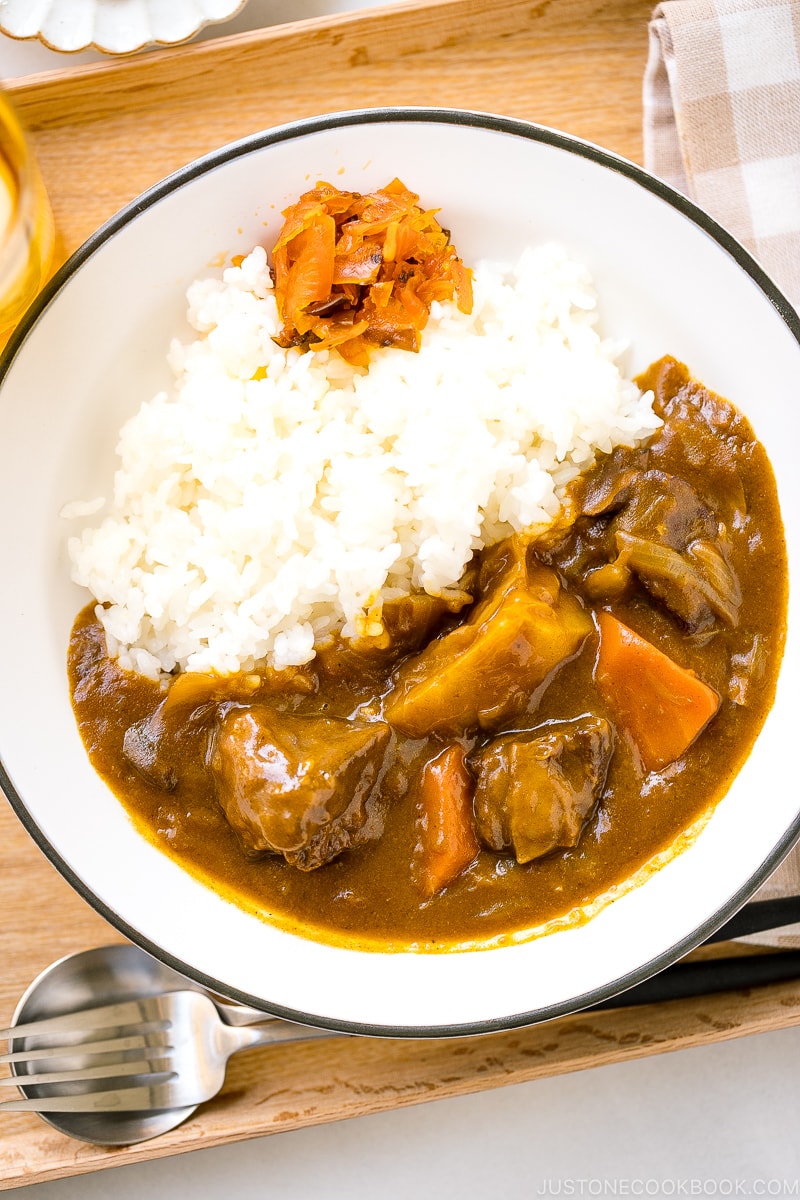
Japanese Curry Rice or Karē Raisu (カレーライス) is an extremely popular dish for all ages in Japan. We adore our curry so much that it is considered one of the country's national dishes along with ramen and gyoza! In this recipe, I'm bringing you a most comforting Japanese Beef Curry (ビーフカレー).
This takes a bit of preparation compared to the Japanese Chicken Curry but the end result is totally worth the effort and time. It's a hearty stew that will satisfy your deepest craving.
Table of Contents
- What is Japanese Curry?
- The Key Ingredient: Japanese Curry Roux
- Adding Flavor Boosters
- Homemade Curry Roux
- How to Make Japanese Beef Curry
- Ingredients You'll Need
- Overview: Cooking Steps
- 5 Important Cooking Tips
- How to Serve the Curry
- How to Store Japanese Beef Curry
- FAQs
- What to Serve with This Japanese Beef Curry
- More Japanese Curry Recipes You'll Love
What is Japanese Curry?
In case you've never tried Japanese curry, I want to quickly introduce it to you as it is quite different from Indian or Thai curry or any other rendition of curry for that matter.
The dish has a long history in Japan and was in fact introduced by the British Royal Navy during the Meiji Restoration 150 years ago. However, it was not until the early twentieth century that curry became a mainstream staple in Japanese households.
A classic Japanese curry commonly features tender morsels of meat, potatoes, sweet bites of onions and carrots, and a thick brown sauce that whispers in a gentle sweetness.
Although most spice aficionados would describe Japanese curry as mellow, the degree of spiciness varies depending how you'd make it. One can always bring up the chili heat if preferred.
Today, you can find many versions of Japanese curry, with some featuring unique local ingredients and produce.
The Key Ingredient: Japanese Curry Roux
To make Japanese curry, the recipes almost always include a box of Japanese curry roux, which can be found at Japanese and Asian supermarkets or in an Asian food aisle at your local grocery stores.
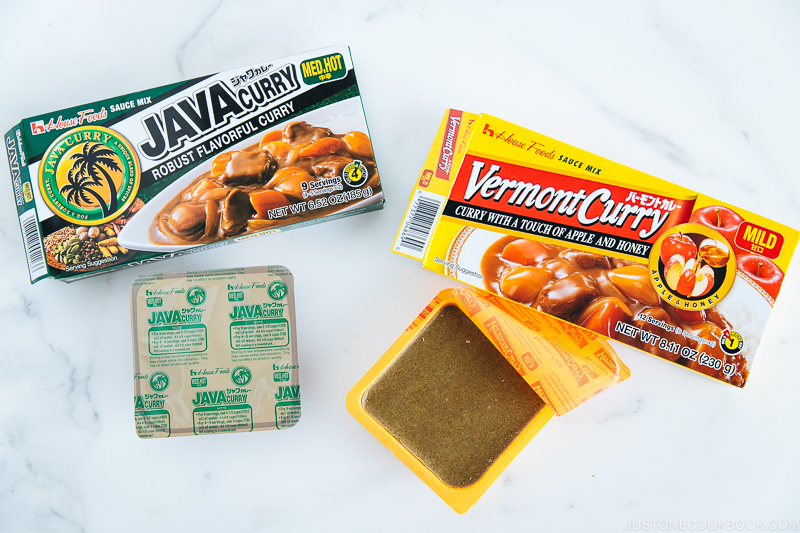
All the curry spices are packed in a form of solid roux resembling a block of baking chocolate. You can find them being labeled according to the spice levels of mild, medium hot, or hot.
Younger children can easily enjoy the "mild" level and now that my kids are older, I mix the mild and the medium-hot for my curries. For those who have toddlers, there is even a Japanese curry roux for toddlers that you may find at Japanese grocery stores.
For those who prefer tingling heat, the "hot" might not be enough for you, but you can certainly punch things up by adding in some cayenne pepper and black pepper.
Adding Flavor Boosters
To avoid "out of the box" taste, it's very common to mix 2-3 different brands of the Japanese curry roux and add different condiments to enhance the flavor for the curry sauce. We'll talk more about it in the cooking tip section below.
Homemade Curry Roux
Not a fan of store-bought curry roux? No problem! You can make it from scratch.
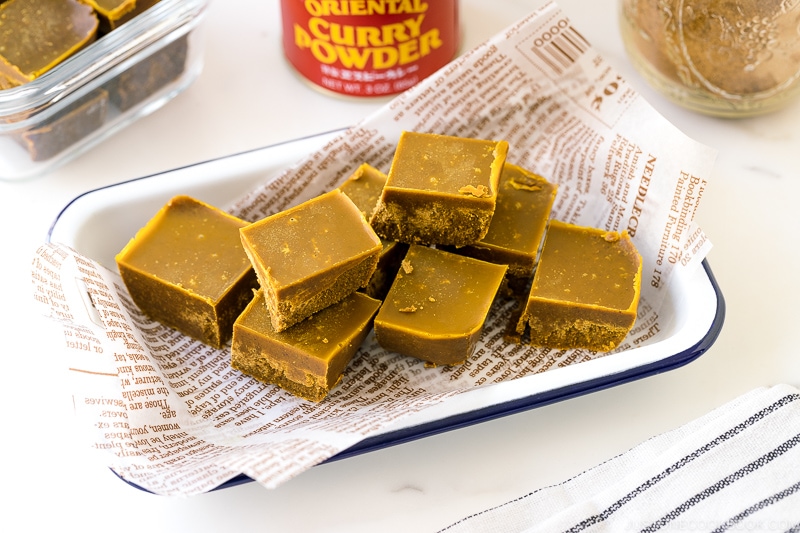
You need 4-5 ingredients to make this curry roux: Butter, flour, Japanese curry powder, and garam masala (and cayenne pepper for the spicy version).
When you have time to make curry roux, make a double batch, and store it in the freezer for later use!
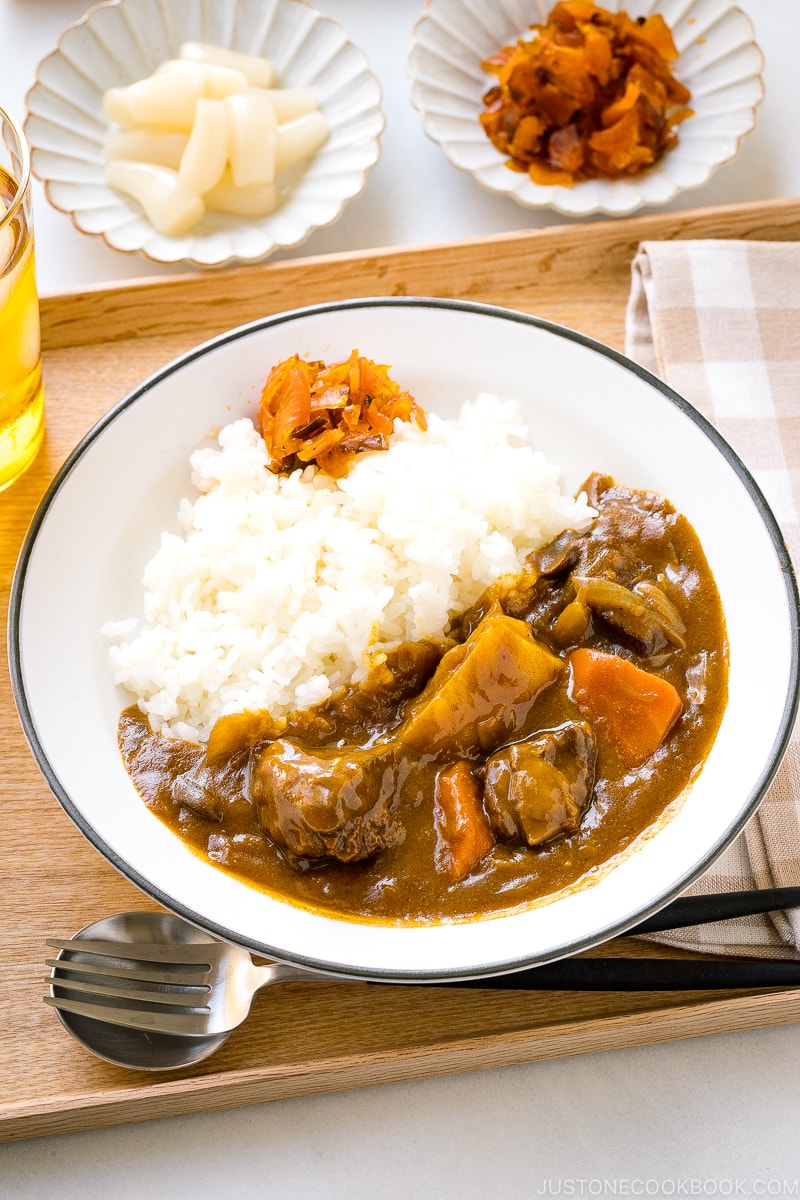
How to Make Japanese Beef Curry
Ingredients You'll Need
- Beef (My top choice is chuck roast; read more later)
- Veggies: onions, potatoes, carrots
- Mushrooms
- Garlic and ginger
- Wine
- Beef stock/broth
- Seasonings: tomato paste, Japanese curry powder, Japanese curry roux, bay leaf, etc
- Optional add-ins: grated apple, milk, Worcestershire sauce
Overview: Cooking Steps
- Cut the onions and start sautéing them until tender and caramelized.
- Meanwhile, cut all the vegetables and beef.
- Sear the beef and add it to the caramelized onion.
- Add the wine, stock, carrots, mushrooms, and seasonings, and cook for 2 hours (add the potatoes 15 minutes prior to finish cooking in order to save their shape).
- Add Japanese curry roux and serve with rice!
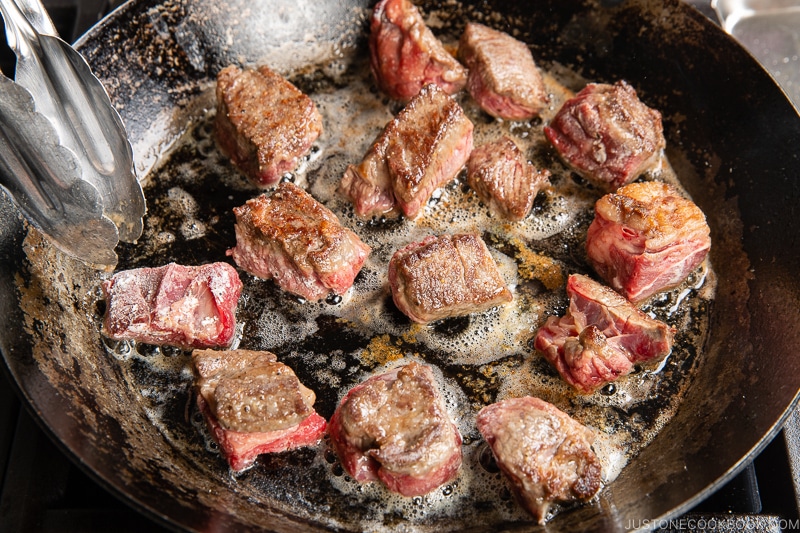
5 Important Cooking Tips
1. Get Chuck Roast instead of Stew Beef
Butcher counters sell pre-cut stew beef. This cut is more economical because it's made up of the odds and ends from other different cuts. Chuck roast, on the other hand, is from the shoulder muscles, and while initially quite tough, cubes of chuck roast can break down into tender, succulent, flavorful meat after cooking low and slow.
So, for a delicious Japanese curry (and of course any beef stew recipe), I strongly recommend getting chuck roast.
For really tender meat, it usually takes two hours. Do not rush the cooking process. Otherwise, the beef will be tough and chewy. Make sure there's enough liquid and keep an eye on the dish. If the recipe calls for less than 1 hour for cooking the beef, it can't be good.
If you can't get chuck roast, try round roast, rump roast, or pot roast.
2. Sear the Meat
This is an essential step if you want to make the most flavorful meat. Searing caramelizes the natural sugars in the meat and browns the proteins, forming a bronze crust on the surface that amplifies the savory flavor of the finished dish.
Once the sauce is thickened, you will be rewarded with a delicious curry with tender pieces of meat in a rich, velvety sauce.
3. Caramelize the Onions
When you slow cook the onions over an extended period of time, the natural sugars in the onions caramelize, bringing out their sweetness and making them extremely flavorful. It takes time, but you can always get the other prep work done while sautéing the onions.
4. Personalize Your Curry with Flavor Boosters
The beauty of curry is its room for customization. Every cook has the freedom to enhance and personalize the flavors with different ingredients (some can be unexpected). You can see the full list in my Japanese Chicken Curry recipe, but here are some of my favorite ones:
- Grated apple
- Honey
- Ketchup
- Butter (Add with roux)
- Garlic (Add while sauteeing)
- Ginger (Add while sauteeing)
- Milk
- Red wine
- Soy sauce
- Tonkatsu sauceor Worcestershire Sauce
Pair one or two of the above with the main ingredients of your curry. For example, I don't use red wine unless it's for a beef curry. Try out different combinations or change up the proportions to see what you like.
5. Add the Potatoes 15 Minutes Before Finishing
Because the beef needs to be simmered for about 2 hours, I like to add the russet potatoes toward the end of simmering. That way, we'll retain the shape of the potatoes instead of them being dissolved into the curry sauce.
You can use Yukon gold potatoes, which tend to keep their shape. But I like the floury, light, and fluffy texture of russet potatoes for the curry.
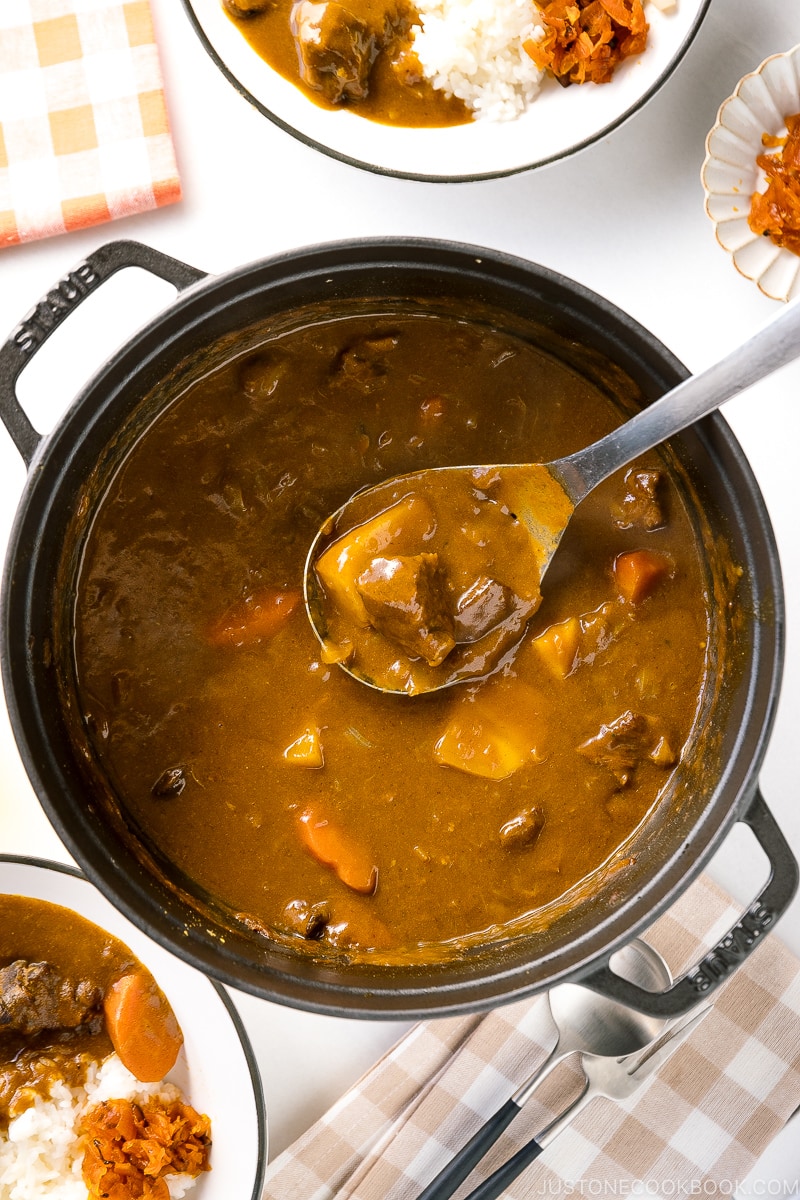
How to Serve the Curry
Japanese curry is almost always served with steamed rice. I have detailed instructions on how to cook Japanese short-grain rice in a pot over the stove, a rice cooker, an Instant Pot, or a donabe (Japanese clay pot).
Serve the steamed rice in half of a shallow bowl, and then add piping-hot curry sauce to fill up the other half of the bowl.
Typically, the Japanese curry is garnished with fukujinzuke (red pickled radish) and rakko (pickled shallots). Put the extra pickles in a bowl/plate on the table so you can add more as you eat.
How to Store Japanese Beef Curry
You can keep the leftovers in an airtight glass container and store them in the refrigerator for up to 3 days or in the freezer for a month. The texture of the potatoes will change in the freezer, so I recommend removing them before freezing.
Defrost the frozen curry in the refrigerator for 24 hours and reheat in a pot to serve. If needed, add ¼ to ½ cup (60-120 ml) of water to dilute the curry when reheating.
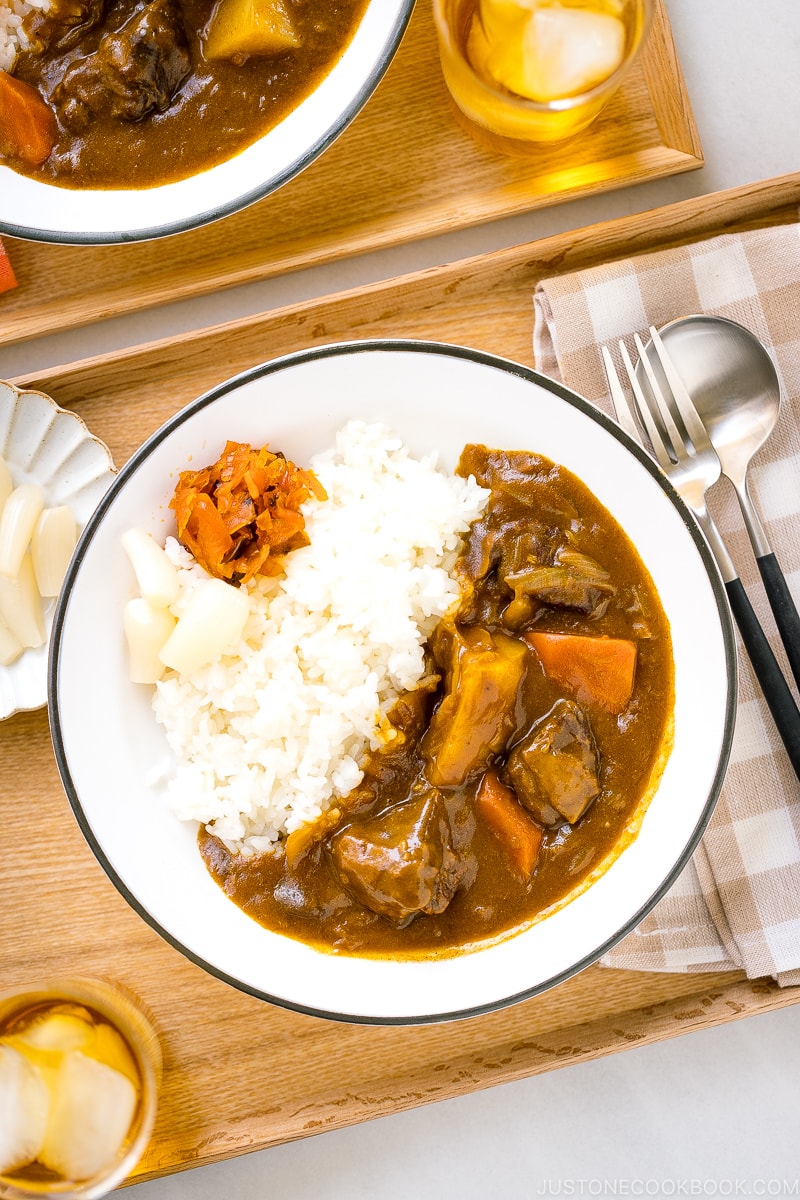
FAQs
I don't have 3 hours to make curry. Are there any other recipes that are quicker?
If you want to cut down on the simmering time for beef curry, you can make my Instant Pot Pressure Cooker Japanese Curry recipe.
Or try my Japanese Chicken Curry or Japanese Seafood Curry!
My broth disappeared while cooking!
When you simmer stews like this for a long period of time, it's very important to use a heavy-bottomed pot with a tight-fitting lid. The pot I use is Staub brand and their lid seals perfectly. Le Creuset is okay, but I still see some evaporation from the gap between the lid and the pot.
Can I make a vegetarian version?
Japanese curry usually includes a protein of your choice (usually beef, chicken, pork, or seafood), onions, potatoes, and carrots. For a vegetarian option, you can add firm tofu right before you serve just to heat it through.
Why is my meat tough and chewy after cooking?
First, I recommend getting chuck roast instead of stew beef. Beef stew meat is typically made up of the odds and ends from other different cuts. Chuck roast is a pretty tough cut, but after cooking low and slow, it becomes melt-in-your-mouth tender.
Secondly, you do need to cook it for 2 hours as all the beef stew recipes do. Do not rush it. Otherwise, the beef will be tough and chewy. Make sure there's enough liquid and keep an eye on the dish.
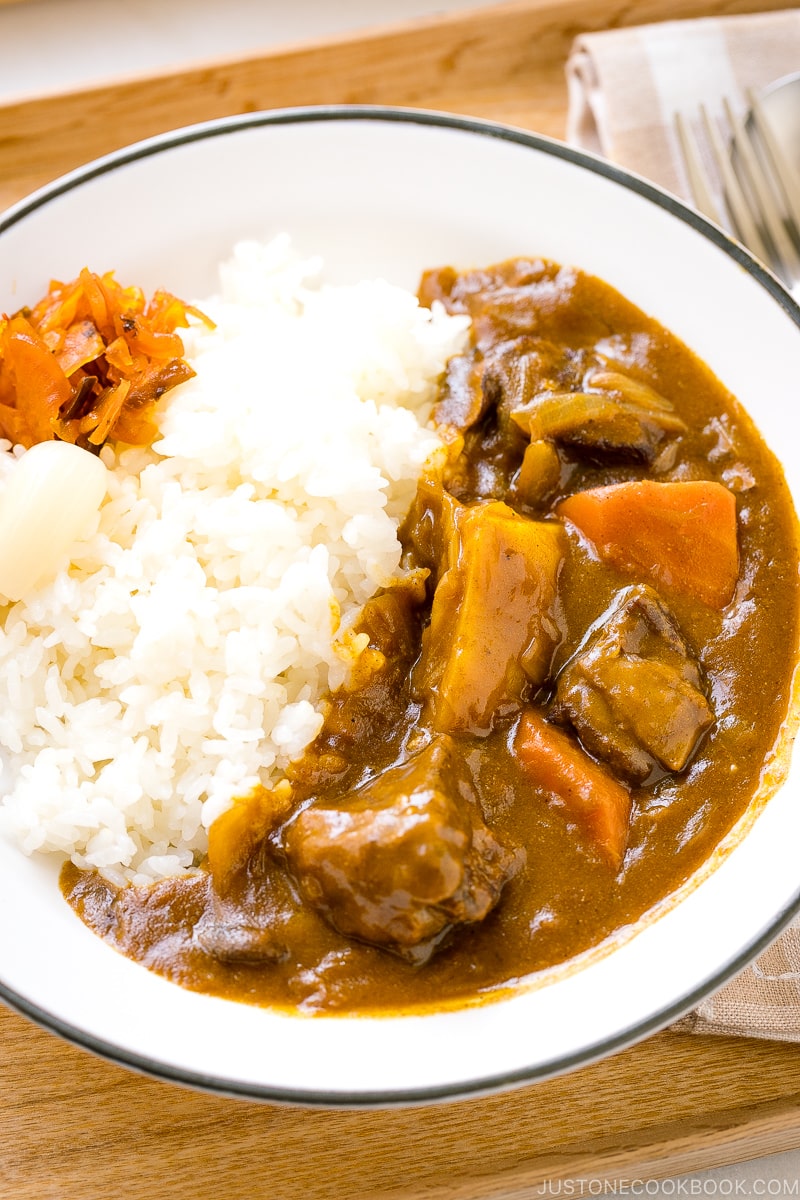
What to Serve with This Japanese Beef Curry
- Japanese Macaroni Salad
- Cold Brew Hojicha (Roasted Green Tea)
- Chicken Katsu or Tonkatsu
More Japanese Curry Recipes You'll Love
- Curry Udon
- Curry Bread (Curry Pan)
- How to Make Japanese Curry Roux
- 15 Japanese Curry Recipes You'll Love
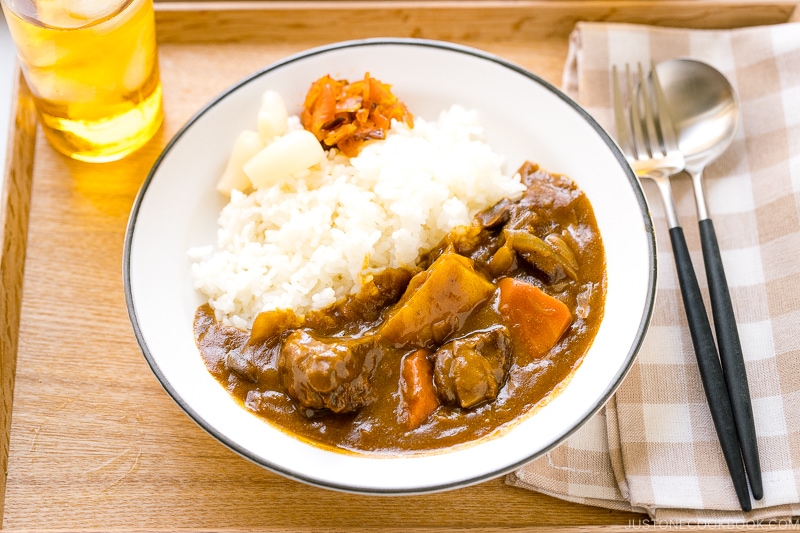
Wish to learn more about Japanese cooking?Sign up for our freenewsletter to receive cooking tips & recipe updates! And stay in touch with me on Facebook, Pinterest, YouTube, and Instagram.
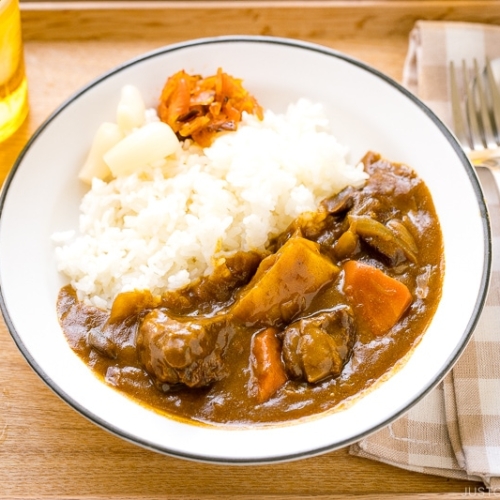
Japanese Beef Curry
Made with beef, potatoes, carrots, mushrooms, and curry roux, this savory and hearty Japanese Beef Curry makes for a fabulous introduction to new curry eaters. Adapted to Japanese tastes, it's mild and sweet with a stew-like consistency. Even children enjoy it thoroughly! You have to give this easy recipe a try.
Servings: 8
Prevent your screen from going dark
- 2 onions (large; 1¼ lb, 567 g for 8 servings)
- 2 Tbsp neutral-flavored oil (vegetable, rice bran, canola, etc.) (divided for the onions and beef)
- 2 Tbsp unsalted butter (divided for the onions and beef)
- 1 russet potato (11 oz, 309 g for 8 servings)
- 1 carrot (large; 8 oz, 230 g for 8 servings)
- 6 cremini mushrooms (2.6 oz, 80 g for 8 servings)
- 1 knob ginger (1 inch, 2.5 cm; ½ tsp grated for 8 servings)
- 1 clove garlic (minced)
- 1¼ lb boneless chuck roast (I recommend chuck roast for its tenderness and higher quality; you can use stew beef as it's slightly more economical, but it's made up of bits and pieces leftover from carving the chuck roasts, so the meat is not as tender)
- ¼ tsp kosher salt (Diamond Crystal; use half for table salt)
- ¼ tsp freshly ground black pepper
- 1 Tbsp all-purpose flour (plain flour)
- ½ cup red wine
- ½ Tbsp Japanese curry powder
- 1 Tbsp tomato paste (or ketchup)
- 4 cups beef stock/broth (1 QT for 8 servings; store-bought beef stock is often salted; for less sodium intake, use 2 cups/480 ml beef stock + 2 cups/480 ml water)
- ⅛ apple (I use Fuji apple; add more for sweetness; substitute 1 Tbsp honey or mango chutney for 8 servings)
- 1 Tbsp Worcestershire sauce
- 2 Tbsp milk
- 1 bay leaf
- 1 box Japanese curry roux (7-8.4 oz, 200-240 g for 8 servings; or use my Japanese Curry Roux recipe)
For Serving
- cooked Japanese short-grain rice (1-1½ cups (180-270 g) per person)
- fukujinzuke (Japanese red pickled vegetables) (optional)
- rakkyo (Japanese pickled scallion) (optional)
Japanese Ingredient Substitution: If you want substitutes for Japanese condiments and ingredients, click here.
-
Gather all the ingredients.
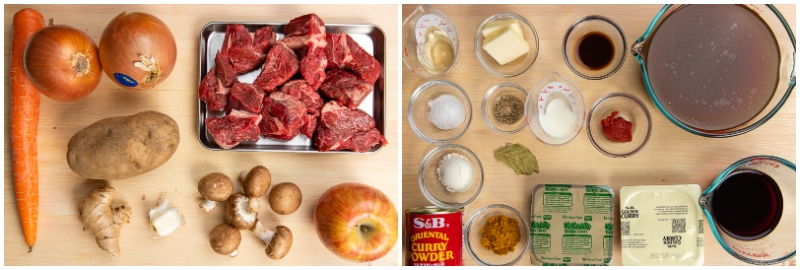
To Prepare the Ingredients
-
Cut the onions into thin slices.
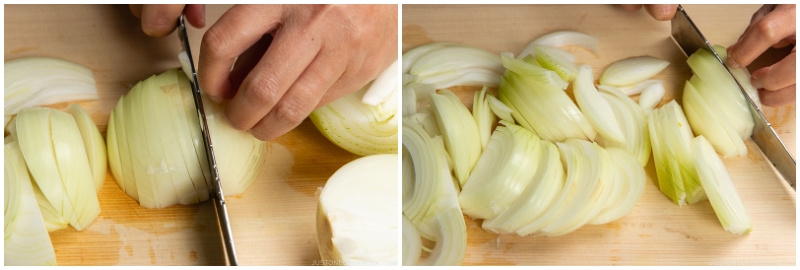
-
Preheat a large heavy-bottomed pot (I used this 5.5 QT Staub Dutch oven) on medium heat. When the pot is hot, add half of the butter, half of the oil, and the onions to the pot. Stir to coat the onions with the oil.
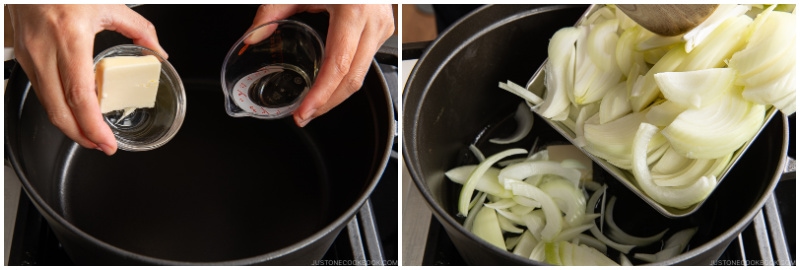
-
Sauté the onions, stirring once in a while, for about 20-25 minutes. Meanwhile, move on to the next step (but stir the onions and keep an eye on them). When the onions are wilted, reduce the stove's heat to medium low (as they tend to burn quickly). Once the onions are tender, translucent, and a bit caramelized, remove the pot from the heat and set aside until the beef is done searing.
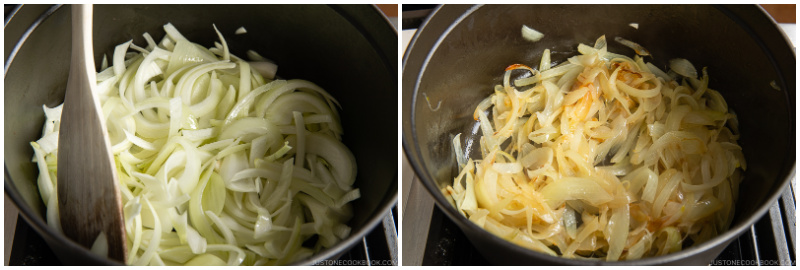
-
Peel and cut the russet potato in thirds.
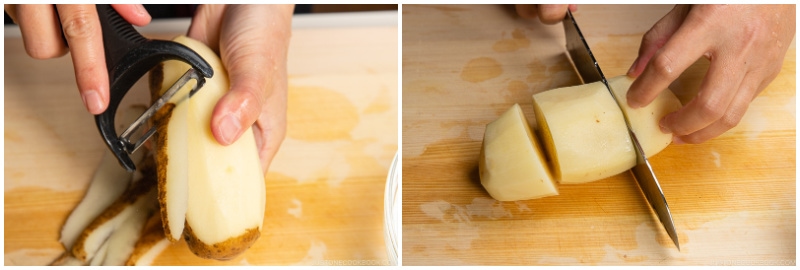
-
Then, cut each piece in half or quarters. Soak the pieces in water for 15 minutes (or until added to the pot later on) to remove the starch. Drain and set aside.
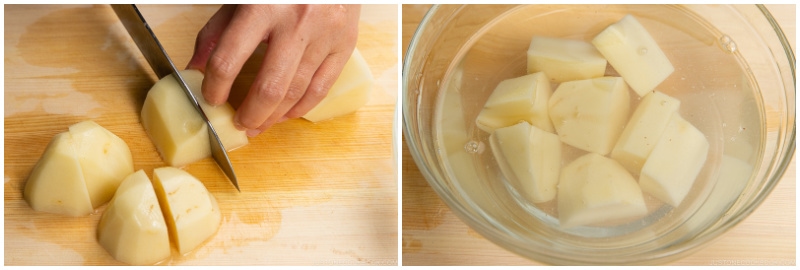
-
Peel and cut the carrot diagonally while rotating it a quarter turn between cuts (we call this cutting technique "rangiri" in Japanese).
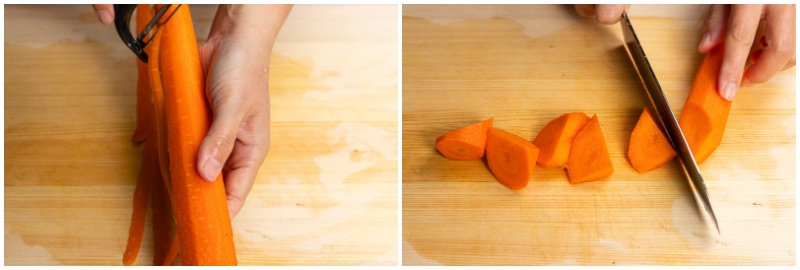
-
Clean the mushrooms. I use a pastry brush and avoid washing mushrooms as they absorb moisture. However, it's okay to quickly rinse them. Then, cut them into thin slices.
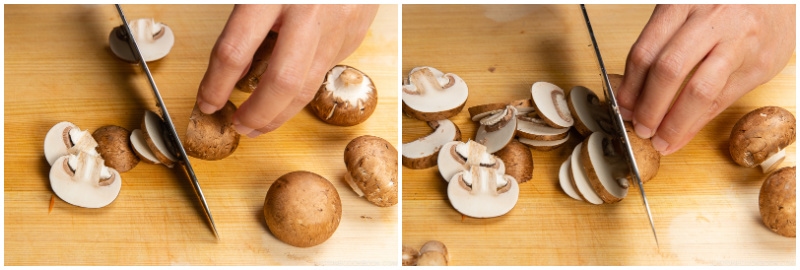
-
Grate the ginger (I use this ceramic grater), measure the amount needed, and set aside. Mince the garlic clove (I skip it here as I use a garlic press).
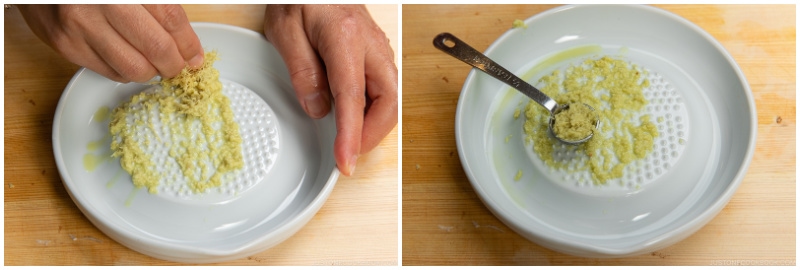
-
Cut the beef into 1½-inch (3.8 cm) cubes.
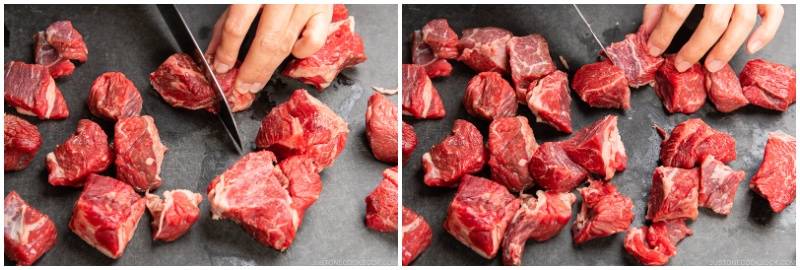
-
Lightly sprinkle the beef with salt and pepper. Then, lightly coat the meat with flour.
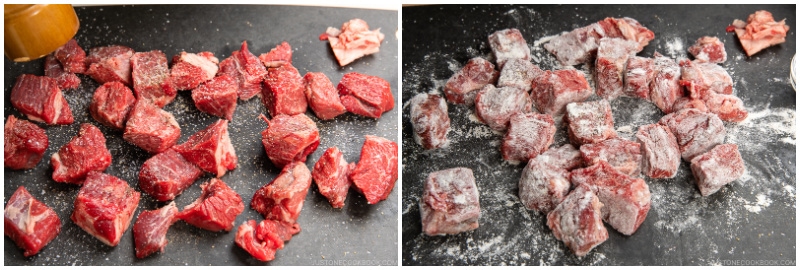
To Cook the Curry
-
Preheat a carbon steel pan (or cast-iron skillet) on medium-high heat. When the skillet is hot, add the remaining oil and butter. Cook the beef in 2 batches. Add the beef cubes in a single layer, making sure not to crowd the skillet; otherwise, the excess moisture in the pan will end up "steaming" the meat.
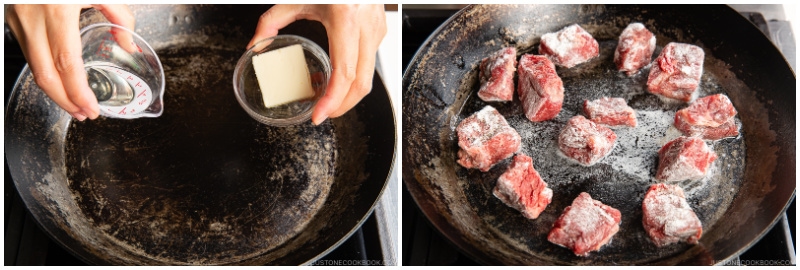
-
Sear the beef cubes (do not move them) on one side until brown and crusty, about 3-4 minutes, then turn them over to cook all sides. The meat will release itself from the pan when the surface is seared nicely. Transfer the seared meat to a plate and work on the next batch.
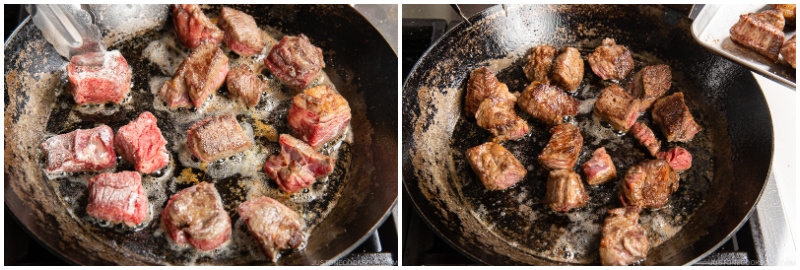
-
Once you've seared all the meat and transferred it to the plate, deglaze the pan. Add the wine to the pan and use a wooden blunt-end spatula to release the flavorful browned bits (called the "fond") that are stuck to the bottom of the pan. Turn off the heat and set aside this deglazed pan liquid temporarily.
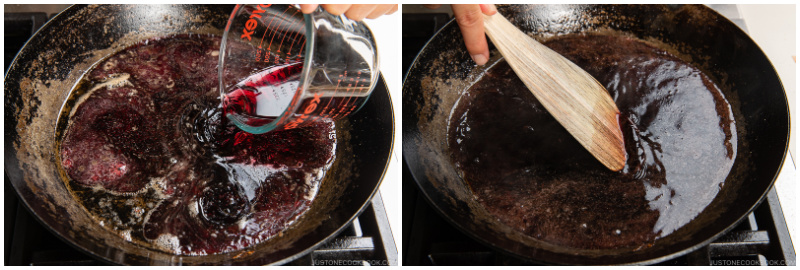
-
By now, the onions in the pot should be caramelized and ready for the next step. Reheat the pot on the stove over medium heat. Add the minced garlic (I use a garlic press) and grated ginger.
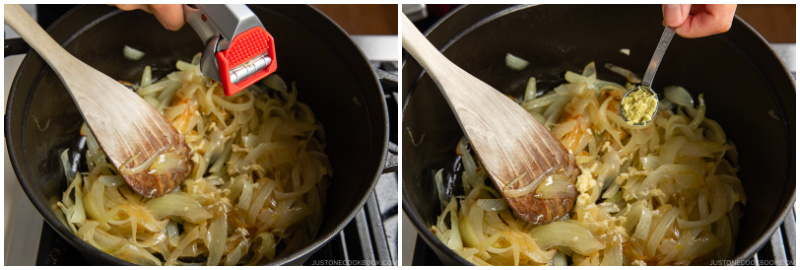
-
Add the curry powder and tomato paste and sauté for 1 minute.
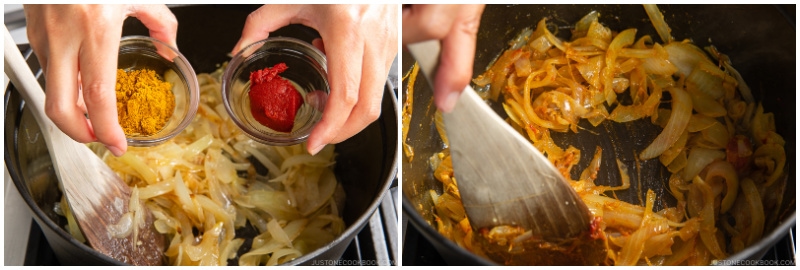
-
Add the seared beef, any juices from the plate, and the deglazed pan liquid to the pot and mix them all together. Cook, stirring occasionally, for 3 minutes, letting the alcohol from the wine evaporate.
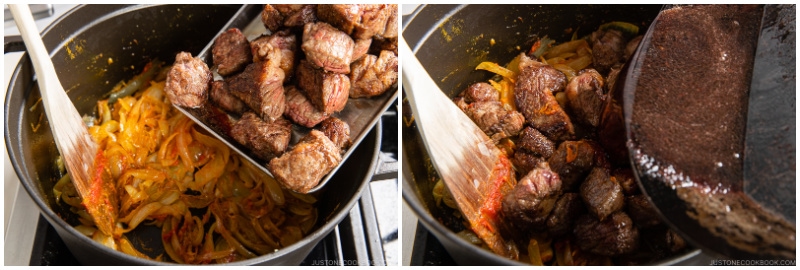
-
Add the carrots and mushrooms and mix them all together. Add the beef stock to just cover the ingredients. Cover the pot with a tight-fitting lid and bring it to a boil.
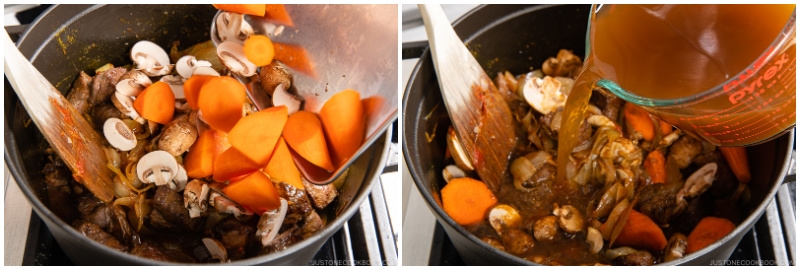
-
Once boiling, skim off the scum and fat from the broth. I prepare a 2-cup measuring cup with water in it and clean my fine-mesh skimmer in the water. It's easy to remove the scum/fat from the skimmer this way.
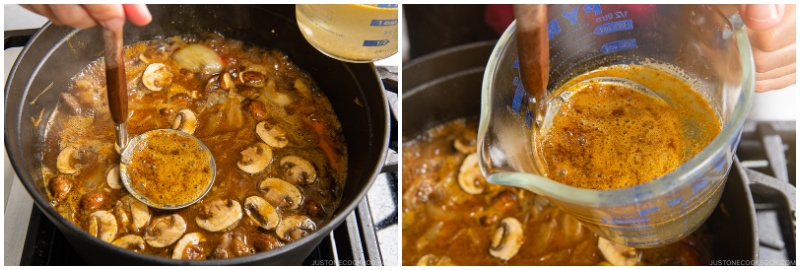
-
Grate the apple and add it to the broth. Then, add the Worcestershire sauce and milk.
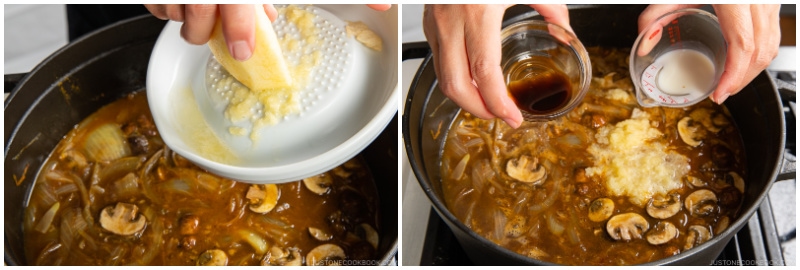
-
Add the bay leaf and cover the pot with the tight-fitting lid. (Tip: Compared to Le Creuset, I think Staub has a great seal on the lid and prevents evaporation). Simmer on low heat until the meat is tender, about 1 hour and 45 minutes. (Tip: To get tender beef, 2 hours of simmering is standard.) If you do not have a tight-fitting lid, you may need to add more beef stock or water, enough to just cover the ingredients.
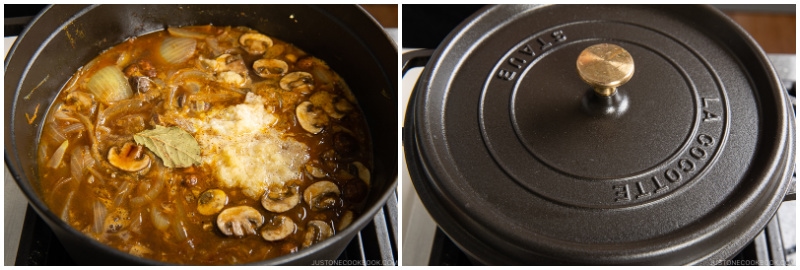
-
When the beef is tender, add the potatoes, close the lid, and simmer for 15 minutes until the potatoes are cooked through.
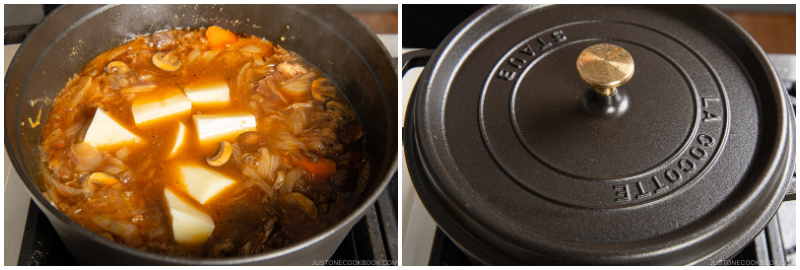
-
When the potatoes are tender (and a wooden skewer can pierce through the potato), turn off the heat and discard the bay leaf.
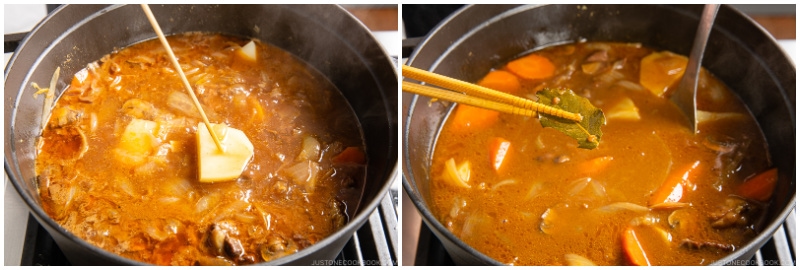
-
Put 1-2 cubes of the curry roux in a ladleful of cooking liquid, slowly let it dissolve with a spoon or chopsticks, and stir it into the broth to incorporate. Repeat with the rest of the blocks, 2 cubes at a time. Adjust the amount of curry roux to your taste. You may not need to use all the roux; reserve the extra cubes for another use. (Keep the leftover roux in an airtight container and store in the refrigerator/freezer for 1-3 months.) After adding the curry roux, simmer on the lowest heat, stirring often, for 3-5 minutes until the sauce has thickened. Be careful not to burn the curry sauce! If the sauce is too thick, add water to dilute. If the sauce is still too thin and soupy, uncover the pot and simmer a bit longer.
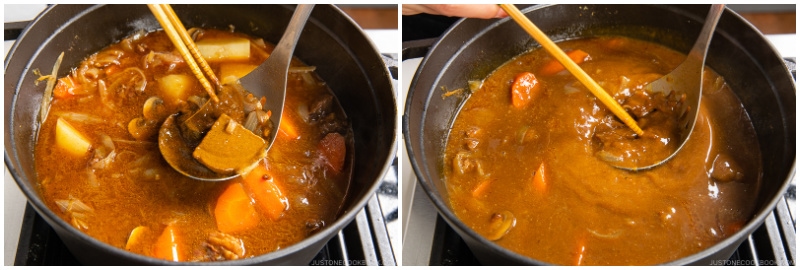
To Serve
-
Serve the curry on individual plates alongside Japanese steamed rice and top with fukujinzuke (pickled radish) and rakkyo (pickled scallion).
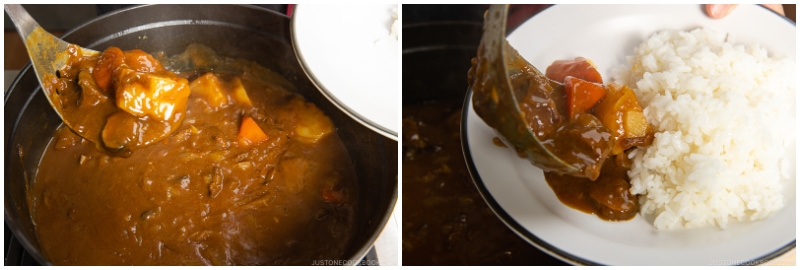
To Store
-
Keep the leftovers in an airtight glass container and store it in the refrigerator for up to 3 days or in the freezer for a month. The texture of the potatoes will change in the freezer, so remove them before freezing. Defrost the frozen curry in the refrigerator for 24 hours and reheat in a pot to serve. If needed, add ¼ to ½ cup (60-120 ml) of water to dilute the curry when reheating.
Calories: 426 kcal · Carbohydrates: 28 g · Protein: 23 g · Fat: 20 g · Saturated Fat: 10 g · Polyunsaturated Fat: 1 g · Monounsaturated Fat: 8 g · Trans Fat: 1 g · Cholesterol: 73 mg · Sodium: 938 mg · Potassium: 873 mg · Fiber: 4 g · Sugar: 10 g · Vitamin A: 3992 IU · Vitamin C: 13 mg · Calcium: 66 mg · Iron: 3 mg
Course: Main Course
Cuisine: Japanese
Keyword: beef, curry
©JustOneCookbook.com Content and photographs are copyright protected. Sharing of this recipe is both encouraged and appreciated. Copying and/or pasting full recipes to any website or social media is strictly prohibited. Please view my photo use policy here.
If you made this recipe, snap a pic and hashtag it #justonecookbook! We love to see your creations on Instagram @justonecookbook!
Editor's Note: This post was originally published on April 15, 2011. It has been updated with new pictures and video and the recipe instruction was slightly revised on May 15, 2022.
Source: https://www.justonecookbook.com/japanese-beef-curry/
0 Response to "What Type of Curry Is Best With Beef"
Post a Comment